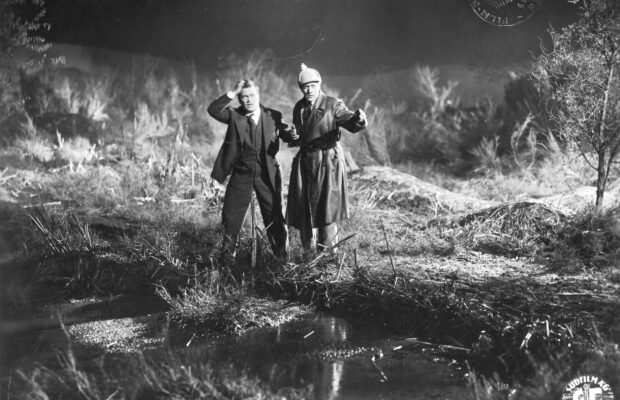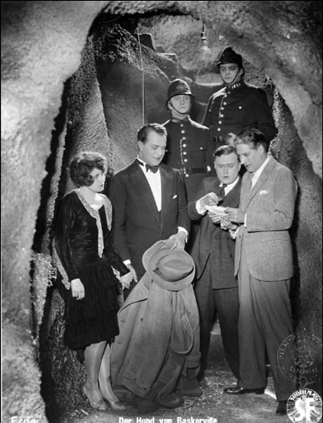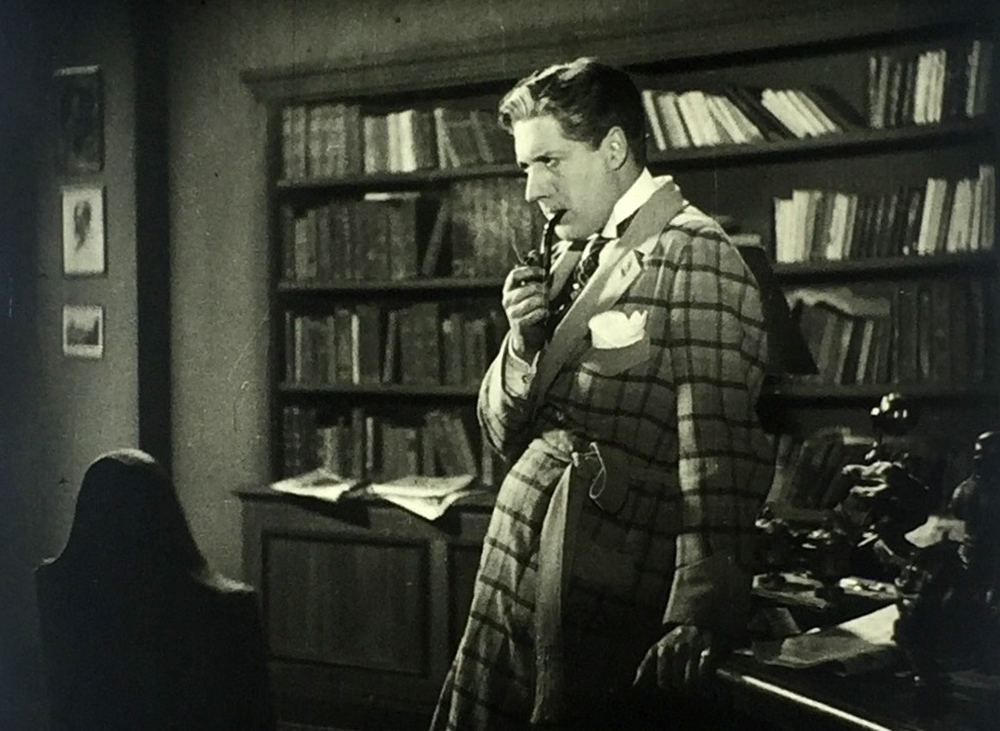Der Hund von Baskerville (1929)

Toronto Film Society presented Der Hund von Baskerville (1929) on Saturday, January 20, 2024 as part of the Season 76 Virtual Film Buffs Screening Series, Programme 5.
Production Company: Erda-Film. Producers: Fred Lyssa, F. W. Kraemer. Director: Richard Oswald. Screenplay: Georg C. Klaren, Herbert Juttke, Sir Arthur Conan Doyle’s 1902 novel, The Hound of the Baskervilles. Cinematographer: Frederik Fuglsang.
Cast: Carlyle Blackwell (Sherlock Holmes), Alexander Murski (Lord Charles Baskerville), Livio Pavanelli (Sir Henry Baskerville), Betty Bird (Beryl), Fritz Rasp (Stapleton), George Seroff (Dr. Watson).
The last silent film to feature Arthur Conan Doyle’s eminent detective has been less a legend than a rumor among cinephiles and Sherlockians. The Hound of the Baskervilles (Der Hund von Baskerville), a seven-reel film with a long German pedigree that even included a movie written while the country was fighting a ghastly war against the detective’s homeland, has long been considered the most important of the Hounds made in Europe. Long pronounced lost, it was filmed in Berlin in early 1929 when German studios were the envy of the world and then almost immediately dropped out of sight. Until recently it was remembered, if at all, for its eerie red poster of a wolfhound exhaling a torch-like light over ghostly ruins.
The film was directed by Richard Oswald, a respected filmmaker with a strong connection to both Holmes and the Hound. For cultural historians, Oswald is famous for directing Different from the Others (1919) starring Conrad Veidt, a powerful attack on Germany’s anti-sodomy laws and a gay rights landmark. But this was only one of eighty-three silent features Oswald directed. In a prolific career, he wrote, produced, and directed thrillers, horror films, historical romances, romantic farces, spicy sex exposés, and, after sound came in, musical comedies and operettas.
Hound was one of his last silents, marked by an international cast—the six leads hail from six different countries—and, even though made by a small Berlin studio (some might say fly-by-night), lavish sets and bravura camerawork. His Holmes was Carlyle Blackwell, an American with a colorful acting career as a matinee idol for Vitagraph beginning in 1910 and later leading roles in British features. His Holmes projects the genial warmth of a brainy cruise director perpetually on the alert.

He plays off George Seroff’s bashful Watson, in arguably the first Holmes film to make the Holmes-Watson friendship a central part of the story. True, Seroff turns Watson into an adoring naïf, but Seroff gives personality to a character who up to now had been notoriously colorless or missing altogether in Holmes silents.
The best-known actor in the cast, however, is Fritz Rasp as Stapleton, Germany’s ubiquitous film villain. He is one of the few Germans in the cast (the film’s Sir Henry Baskerville is Italian; Beryl Stapleton is Austrian; Dr. Mortimer is Czech), best known today as the scoundrel who seduces Louise Brooks in Diary of a Lost Girl and the thief pursued by children in Emil and the Detective. But Rasp, too, is overwhelmed by the film’s true scene stealer: the Hound’s moor, a vast indoor set built inside the abandoned Staaken zeppelin hanger, rivaling in enormity even what 20th Century Fox built for Basil Rathbone ten years later.
The film never came to the United States, but it played from one end of Europe to the other. When Conan Doyle visited the continent in October 1929 he could have seen his story screened in Germany, Italy, or the Benelux countries. Instead he attended its Danish premiere in Copenhagen, shortly before the film opened throughout Scandinavia, Czechoslovakia, Hungary, and Ukraine. The film did well enough that Pathé then released a shortened version for the home movie market on 9.5mm. The Nazis even remade it in 1937, produced by screen star Anny Ondra. This was the version Hitler kept in his retreat at Berchtesgaden.
So why, with all this success, have you never heard of it? Most likely because the film was never released over here. By August of 1929, the fateful year when the film opened, American movie houses had been mostly converted to sound and were no longer in the market for silent pictures, least of all foreign-language imports with no big-name movie stars. Its fate was sealed when UK’s Gainsborough Pictures decided to make a talkie version of The Hound two years later and, despite mediocre reviews, found a way into the English-language markets that Oswald’s film never could.
What American audiences missed was a strange, fascinating hybrid: part Conan Doyle, but mainly descended from a uniquely German line of adaptation. Oswald himself was an important part of that tradition. He had written a stage version of The Hound in 1906 and, thanks to his brief career at Berlin’s Deutsche Vitascope Company, worked on the highly popular Sherlock Holmes series starring Alwin Neuss. These include his first film adaptation of Hound, a feature based not on his own play but the far more famous—though no less eccentric—version written by German matinee idol Ferdinand Bonn.
These became Oswald’s bizarre Teutonic templates. That 1914 Vitascope film feature, for instance—the one Oswald adapted and Rudolf Meinert directed— is arguably the zaniest Hund ever produced. For starters, it is set, like Bonn’s play, in Scotland, meant to exude Sir Walter Scott’s atmosphere of weirs and haunted castles. From the waist down, the villagers look straight out of “The Banks and Braes of Bonnie Doon”; from the waist up they’re in Old Heidelberg. Nor will viewers soon forget Holmes disguised as the villain with the villain disguised as Holmes in a shootout broken up by a manservant hidden inside a suit of medieval armor. This is Holmes reconfigured as a Nick Carter action figure confronting a villain out of a Feuillade serial, the two of them puffing away amid torture chambers, sliding panels, and booby-trapped libraries.

By 1929, the now-seasoned director had calmed down considerably, and the film that emerged was not only recognizable as Conan Doyle’s tale, but also a highly effective thriller. However, the earlier German productions tag merrily along. The secret panels, the suit of armor with moving eyes, and Stapleton’s diabolical booby traps are all still here, with new add-ons. Stapleton now has a bow and arrow; Baskerville Hall has a portrait of the hellhound, a cross between a dog and a dragon; Holmes is slimed in an underground mud slurry; and a telephone with an extra-long cord is turned into a diabolical tool. The wittiest innovation: Watson reading Edgar Wallace’s crime story The Squeaker in bed while the boards creak in the hall. Could Watson merely be imagining Edgar Wallace’s squeak, or is the squeaker real? More intriguing, could Oswald be plugging his production company’s 1929 film version of Der Zinker, also featuring a villainous Fritz Rasp?
So, Conan Doyle purists are hereby warned. But what makes this fun, rather than simply absurd, is the great sincerity and energy with which it’s made, perfectly capturing the pleasures of a Saturday morning entertainment. Oswald had learned a thing or two from the great German masters, particularly Paul Leni whose American productions The Cat and the Canary and The Man Who Laughs had enjoyed great success in Berlin, and he applies the chiaroscuro lighting, odd angles, and creep-along camera movements with great relish.
The film’s discovery, when it came, had its own Hound-like features. A 35mm nitrate original with Czech intertitles was found in 2009 in the Polish industrial city of Sosnowiec, along with nine other silent films, their existence revealed by what Conan Doyle would have called “an odor of decay and heavy miasmic vapor.” They had been stored—some accounts say hidden—in the basement of a parish priest who had had a weakness for collecting foreign (that is, non-Polish) films and screening them for friends. However, by the time he died, several of the films were decomposing. Sensibly, the collection was donated to Poland’s National Film Archive in Warsaw, where The Hound remained untouched for the better part of a decade. Financial and political factors prevented the archive from attempting an immediate restoration, but a partnership with the San Francisco Silent Film Festival broke the Gordian knot. The great news: what survived was not a worn-out exhibition dupe, but an original distribution master in near-mint condition. True, a reel was missing, but some of that footage has been supplied from a 9.5mm Pathé-Baby print held by a film collector in Vienna. Almost ninety years after its original release, the unleashed Hund is at last ready for a new run.
Notes by Russell Merritt










Leave a Reply